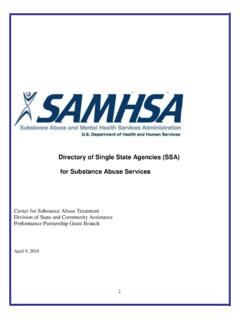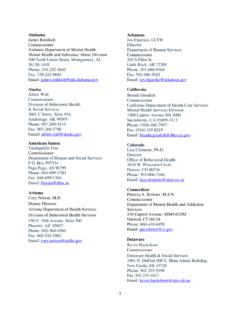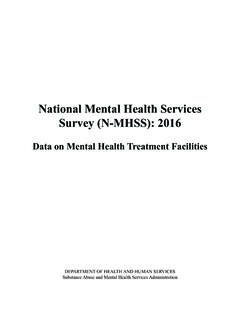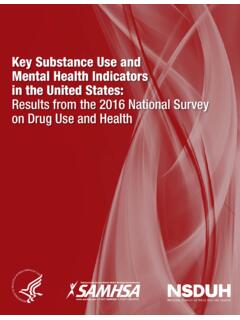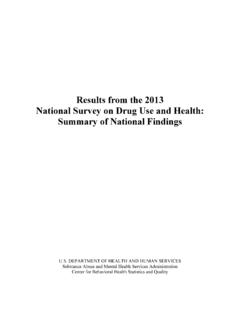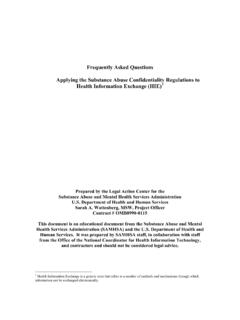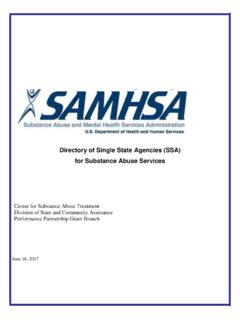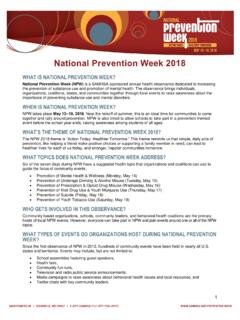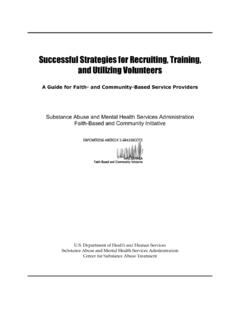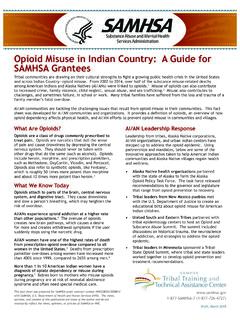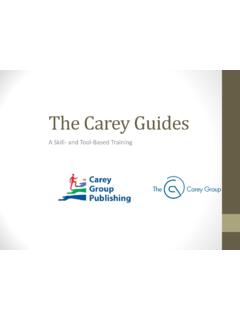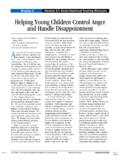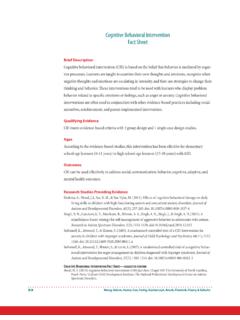Transcription of SAMHSA Disaster Technical Assistance Center …
1 SAMHSA Disaster Technical Assistance Center Supplemental Research Bulletin: Disaster behavioral health interventions inventory May 2015 This Supplemental Research Bulletin is an inventory rather than a review of current research in the field of Disaster behavioral health (DBH). The inventory primarily comprises Disaster -specific interventions , although several may also be used to assist people who are suffering with distress or disorders associated with other types of traumatic events. The interventions used to support survivors of other types of traumatic events are generally applicable to Disaster survivors in the later stages of response activities. Finally, a few of the interventions (those used in the long-term recovery phase of Disaster ) are applicable only when the survivors have been fully assessed by a licensed or certified professional and determined to have a diagnosable disorder, such as major depression, posttraumatic stress disorder (PTSD), or other anxiety-related disorders.
2 The immediate and intermediate interventions help achieve two goals of Disaster behavioral health : Mitigate the development of serious mental disorders. Provide tools that support the natural recovery process that occurs with time for themajority of the affected majority of interventions applied in the acute/immediate and intermediate response phases are appropriate for survivors who continue to function well but may have continuing bothersome symptoms and who have not been formally diagnosed with a mental illness. According to a recent study, the prevalence of PTSD 6 years after a Disaster was percent, and the current prevalence was percent, with onset mainly within 1 month and remission within 3 years Many variables contribute to whether a person will experience PTSD, such as their history of trauma, preexisting mental health condition, socioeconomic status, access to social supports, and other influences.
3 These survivors should be provided with treatment options as soon as their condition has been identified, or as soon as they have been formally assessed by a mental health professional. Formal mental health treatment services are at the far end of the spectrum in terms of DBH. Most interventions are categorized by the time in which they should be administered after a Disaster (early, intermediate, and long term) and can be applied to the majority of survivors who experience the most common reactions. interventions that are available via Internet, smartphone applications, and other electronic technology are inventoried within their own category. We also use checklists that identify standard aspects of each intervention, including: The modality by which they can be delivered ( , individual, family, group) The settings in which they can be delivered ( , in the field, in schools, at theworkplace) The status of their research base (with a wide spectrum from empirical evidence tounpublished) ReferencesWe hope this inventory of interventions is helpful to your work in responding to the behavioral health needs of Disaster survivors.
4 Warmest regards, CAPT Erik Hierholzer, Program Management Officer, Emergency Mental health and Traumatic Stress Services Branch Nikki Bellamy, Public health Advisor, Emergency Mental health and Traumatic Stress Services Branch Brenda Mannix SAMHSA DTAC Project Director i Arnberg, , Johannesson, , and Michel, P. (2013). Prevalence and duration of PTSD in survivors 6 years after a natural Disaster . Journal of Anxiety Disorders, 27(3), 347-352. Please note: SAMHSA does not officially endorse each intervention; rather this document presents intervention practices commonly used in the field and reported in the science- and evidence-based research literature. CONTENTS EARLY interventions .. , Crisis Intervention, and Trauma Treatment (ACT).
5 behavioral Therapy for Acute Stress Disorder (CBT for ASD) .. Emergency Response Teams (CERT) .. , Outreach, Debriefing, Education, and Crisis Counseling Disaster Mental HealthService Model (CODE-C DMHSM) .. Counseling Assistance and Training Program (CCP) .. Incident Stress Debriefing (CISD) .. Psychological Intervention (EPI) .. Families GOALS Project: Going on After Loss .. Crisis Intervention: Public Mental health Service Delivery Protocols: Group Interventionsfor Disaster Preparedness and Response .. After Trauma Skills (HATS) .. Organization for Victim Assistance (NOVA) Crisis Response Team (CRT) .. Solace Program Model .. First Aid (PFA) .. PFA RAPID Model .. PFA .. for Schools.
6 Workforce Resilience Through the Practice of Psychological First Aid A Course forSupervisors and Leaders (PFA-L) .. 17 Rapid Mental health Triage and Incident Management System .. , Protect, Connect Model of PFA .. Efforts After Adult and Child Trauma (REACT) .. , Brief Intervention, Referral to Treatment (SBIRT) .. Safety .. health First Aid (MHFA) .. 24 INTERMEDIATE interventions .. behavioral Therapy for Post- Disaster Distress (CBT-PD) .. Intervention (CBI) .. behavioral Intervention in Schools (CBITS) .. Therapies .. for Psychological Recovery (SPR) .. Crisis Counseling Services (SCCS) .. for Recovery .. 33 LONG-TERM interventions .. 34 Processing Therapy (CPT) .. Movement Desensitization and Reprocessing (EMDR).
7 Inoculation Training (SIT) .. Exposure Therapy .. Psychotherapies .. Training in Affect and Interpersonal Regulation (STAIR) .. Desensitization .. cognitive behavioral Therapy (TF-CBT) .. Systems Therapy (TST) .. 44 INTERNET-BASED interventions (IBIs)/APPLICATIONS (APPS) .. 46 Processing Therapy (CPT) Coach Mobile App .. Distress Helpline/TalkWithUs .. Disaster Recovery (web based) .. Suicide Prevention Lifeline 50 .. COACH .. Back/Bounce Back Now (technology based) .. 52 APP-BASED RESOURCE TOOLS FOR RESPONDERS .. 53 behavioral health Disaster Response App .. Suicide Safe Mobile App53 .. First Aid (PFA) Mobile App .. 53| Page 1 EARLY interventions A National Institutes of health study published in the International Journal of Emergency Mental health in 2005 examined the behavioral health of a sample of New York City residents 2 years after 9/11.
8 The authors recommended that crisis intervention services should be considered as a first line of emergency management for those potentially affected by large-scale community disasters. 1 Early interventions are typically defined as any form of psychological intervention delivered within the first 4 weeks of a potentially traumatic Some early interventions are intended for implementation during the acute phase (within hours or days of a traumatic event), whereas others are initiated 1 to 4 weeks post These interventions are meant to lend survivors the strengths needed to decrease their fear responses (thereby calming themselves) and access immediate care and support, allowing them to move to the next stage of recovery.
9 , Crisis Intervention, and Trauma Treatment (ACT)Author: Albert R. Roberts Website: Brief Description: ACT is a conceptual three-stage framework and intervention model that can be useful in helping mental health professionals provide acute crisis and trauma treatment services. This model may be thought of as a sequential set of assessments and intervention strategies, as it integrates various assessment and triage protocols with the seven-stage crisis intervention model and the 10-step acute traumatic stress management protocol. Delivery Mode Individual Family (general) Group Community Victim Family Direct Survivors Rescue and Recovery Responders Other RespondersDelivery Setting Family Assistance Centers Field/Community Private Homes Schools (general) Classrooms Faith-Based Settings Responder Agencies Other Research Base Empirically Supported Treatment (EST) Evidence-Supported Treatment (EST) Evidence-Informed or Evidence-BasedBehavioral Practice (EBBP) Qualitative Research 1 Boscarino, , Adams, , & Figley, (2005).
10 A prospective cohort study of the effectiveness of employer-sponsored crisis interventions after a major Disaster . International Journal of Emergency Mental health , 7(1), 9 22. 2 National Institute of Mental health . (2002). Mental health and mass violence. Evidence-based early psychological intervention for victims/survivors of mass violence. A workshop to reach consensus on best practices. NIH Publication No. 02- 5138. Washington, DC: Government Printing Office. 3 Bryant, , Harvey, , Dang, , Sackville, T., & Basten, C. (1998). Treatment of acute stress disorder: A comparison of cognitive - behavioral therapy and supportive counseling. Journal of Consulting and Clinical Psychology, 66(5), 862 866. | Page 2 behavioral Therapy for Acute Stress Disorder (CBT for ASD)Author: Richard Bryant, University of New South Wales, Australia Website: Brief Description: ASD encompasses posttraumatic stress reactions that are present just after an event until 4 weeks post-trauma.
